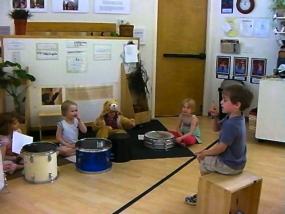Reinventing Music Notation

The pre-kindergarten class featured in this video has been investigating several musical concepts for several months. In this experience, Jack is conducting his classmates in a drum ensemble. Before the video begins, the children were all playing the drums at the same time and were expressing frustration about being heard. Jack and his friend came up with a solution that the class agreed upon. Each person would be assigned a number, and when his/her number was called, it would be his/her turn to play. When children develop their own system of rules, are they more invested in following them? Notice how all of the drummers are engaged and responding to Jack’s instruction as they wait for their number to be called. Jack then uses the numbers to conduct, rather than his voice. Was this another rule created by the children to move the focus back to the sound of the drum? By giving Jack the numbers, we hear only the sounds of the drums being played. Notice that Jack not only holds up a number, he also extends it forward as if to signal “hit now.” The children spontaneously invent a game of beating Jack to his signal. They hit their respective drums at the first indication of what number he is about to lift. They laugh. Perhaps waiting for their number, or anyone’s number, has become too much to ask six drummers, in spite of the impulse control they have shown up to this point. Also, because Jack holds up only one number at a time, drums with different tonal values are never hit at the same time. Their impatience could actually be the catalyst for new rules about how they use these numbers. Let’s assume the teacher comments on how long they have to wait and suggests they invent new rules that bring more drumming into play. The children might suggest Jack hold up more than one number. If this is cumbersome, the teacher might offer to make more than one copy of each number and put Velcro on the backs of the copies, so they stick to a vertical fabric board. Once the children see their numbers lined up, maybe even some on top of another (simultaneous hits), it would be reasonable to assume they would see the potential of spacing the numbers at different intervals, thereby capturing not only the sequence of the drum hits, but also the interval of time between hits. Now, the children have reinvented the beat. This real episode and its imagined extensions provide us with a wonderful example of constructivist teaching, where children invent and reinvent symbolic rules because they have experienced the problems one has without them. To understand is to invent a solution to a problem one has experienced. Length of video: 1 minute 37 seconds Keywords: Fives, Children-Children, Drums, Literacy, Symbols, Notation, Music
